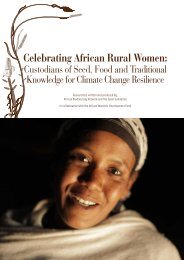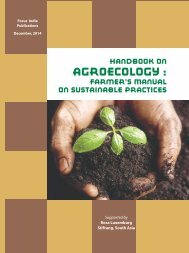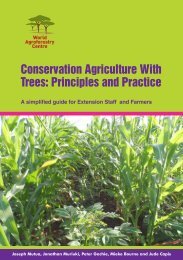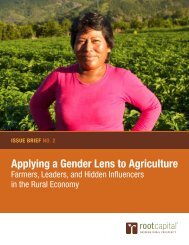1t0SC7l
1t0SC7l
1t0SC7l
You also want an ePaper? Increase the reach of your titles
YUMPU automatically turns print PDFs into web optimized ePapers that Google loves.
However, during the two years cropping period in our study area, soil porosity was reduced by 10<br />
to 20% (Figure 3.3) as inferred from increase in bulk density and clay content decrease. This is<br />
indeed, followed by increasing surface runoff and erosion hazard.<br />
Although erosion increases, little sediment ends up in the rivers. Waterloo et al. (2000) reported<br />
that sediment yields in three rivers in the area varied from 56 kg ha -1 yr -1 for a catchment in<br />
unlogged forest to 339 kg ha -1 yr -1 for a catchment in an area where logging and shifting<br />
cultivation is practised. They concluded that human activities may affect the sediment load in the<br />
rivers, but that this effect is modest compared to other tropical areas and does not give reason for<br />
concern.<br />
Soil porosity changes<br />
70<br />
Porosity (%)<br />
60<br />
50<br />
40<br />
0-10(Ebim)<br />
10-20 (Ebim)<br />
0-10 (Nyan)<br />
10-20 (Nyan)<br />
30<br />
CF1 CF2 CF3 BF1 BF2 BF3 FF1 FF2 FF3 FV<br />
Sampling period and Fallow types<br />
Figure 3.3: Soil porosity changes during the cropping period<br />
Keys: CF1 = Soil under Chromolaena fallow (1996); CF2 = Soil at the beginning of the cropping period<br />
(1996) of field cleared from Chromolaena fallow; CF3 = Soil at the end of the cropping period<br />
(1998) of field cleared from Chromolaena fallow. BF1 = Soil under Bush fallow (1996); B2 = Soil<br />
at the beginning of the cropping period (1996) of field cleared from Bush fallow; BF3 = Soil at the<br />
end of the cropping period (1998) of field cleared from Bush fallow. FF1 = Soil under Forest fallow<br />
(1996); FF2 = Soil at the beginning of the cropping period (1996) of field cleared from Forest<br />
fallow; FF3 = Soil at the end of the cropping period (1998) of field cleared from Forest fallow; FV<br />
= primary forest. Ebim = Ebimimbang soil; Nyan = Nyangong/Ebom soil<br />
Conclusion. In general, changes in soil chemical and physical properties observed after two years<br />
under cultivation were modest. However, soil physical properties were significantly affected<br />
negatively by cropping likely leading to the increase in soil erosion hazard.<br />
3.3.2 Fallow age and soil regeneration<br />
Fallow is essential in shifting cultivation systems. When crop yield drop under a level judged<br />
acceptable by farmers, the field plot is abandoned to the dynamic of natural fallow.<br />
The natural fallow re-growth<br />
After slashing and burning a tract of primary forest, a new vegetation dynamic is set in place<br />
during the fallow period. From an imaginary land cover transect going from a 2-years fallow to a<br />
more than 20-years fallow, the following evolution of the vegetation types can be observed. At 2<br />
years, the Chromolaena odorata shrub dominates the vegetation whereas the seeds of pioneer<br />
species germinate under its cover. These pioneer species grow rapidly and after 5 to 8 years, they<br />
replace completely Chromolaena, which is shade intolerant. Seedlings of other forest species<br />
appear and grow under the pioneer species. Forest species will replace pioneer species after about<br />
35








